
| Introduction | p. 1 |
| Public relations in business: an introduction | p. 3 |
| What is PR? | p. 3 |
| What PR is not | p. 5 |
| Strategy or tactics? | p. 7 |
| Legal boundaries | p. 8 |
| Practical considerations | p. 9 |
| Summary and activities | p. 11 |
| Where PR sits with advertising and marketing | p. 13 |
| PR and advertising | p. 15 |
| What do the marketers think of PR types? | p. 16 |
| How do marketers use PR? | p. 19 |
| Summary and activities | p. 22 |
| Understanding strategic public relations | p. 25 |
| Planning your PR | p. 25 |
| Situation analysis, including identifying stakeholders | p. 28 |
| Setting PR objectives | p. 32 |
| Developing PR strategies: creating the message | p. 33 |
| Developing PR tactics | p. 36 |
| Setting timescales | p. 37 |
| Allocating resources | p. 37 |
| Implementing creative | p. 38 |
| Evaluation and reflection | p. 38 |
| Summary and activities | p. 40 |
| Working with the media | p. 43 |
| Advertising | p. 43 |
| Media relations | p. 44 |
| The media | p. 44 |
| How to gain media coverage | p. 46 |
| Summary and activities | p. 59 |
| PR and developments in online communications | p. 61 |
| Managing your reputation online | p. 62 |
| How PR uses social media | p. 66 |
| Challenges in the workplace | p. 67 |
| Using the internet to gain a competitive advantage | p. 71 |
| Summary and activities | p. 72 |
| Stakeholders and customers: how to develop and maximise relations | p. 75 |
| PR as an internal marketing tool | p. 77 |
| Customer satisfaction | p. 83 |
| Emotional intelligence | p. 84 |
| Summary and activities | p. 85 |
| Crisis, what crisis? | p. 87 |
| Planning | p. 87 |
| Who to communicate with during a crisis | p. 88 |
| Saying sorry... mea culpa | p. 88 |
| Being proactive as well as reactive | p. 89 |
| Never say 'no comment' | p. 92 |
| Talking to the media during a crisis | p. 92 |
| Crisis manuals and simulation | p. 93 |
| Summary and activities | p. 94 |
| Internal communications | p. 97 |
| Controlling the message | p. 98 |
| Getting to know your employees | p. 99 |
| Resources for internal communications | p. 103 |
| Tactics for internal communications | p. 103 |
| Employee communication needs | p. 105 |
| Organisational culture | p. 106 |
| Ethical employers | p. 107 |
| Summary and activities | p. 108 |
| Getting the facts right: using research to create a competitive edge | p. 111 |
| Types of research | p. 112 |
| Research methods | p. 113 |
| Create the research plan | p. 115 |
| Analysing and presenting the findings | p. 120 |
| Summary and activities | p. 121 |
| How much should good public relations cost? | p. 123 |
| Which marketing strategies do you wish to drive with PR? | p. 123 |
| How much to invest in PR? | p. 125 |
| Make sure the chemistry is right | p. 131 |
| Evaluation | p. 131 |
| Evaluation of media coverage | p. 132 |
| Summary and activities | p. 137 |
| PR championing ethics and sustainability | p. 139 |
| The business of business is business...? | p. 139 |
| Using PR to overcome barriers to sustainability | p. 141 |
| PR as an internal marketing tool | p. 148 |
| Managing change... or is it changing management? | p. 150 |
| Using support mechanisms | p. 152 |
| Summary and activities | p. 156 |
| Answers to questions | p. 159 |
| References | p. 167 |
| Table of Contents provided by Ingram. All Rights Reserved. |
The New copy of this book will include any supplemental materials advertised. Please check the title of the book to determine if it should include any access cards, study guides, lab manuals, CDs, etc.
The Used, Rental and eBook copies of this book are not guaranteed to include any supplemental materials. Typically, only the book itself is included. This is true even if the title states it includes any access cards, study guides, lab manuals, CDs, etc.